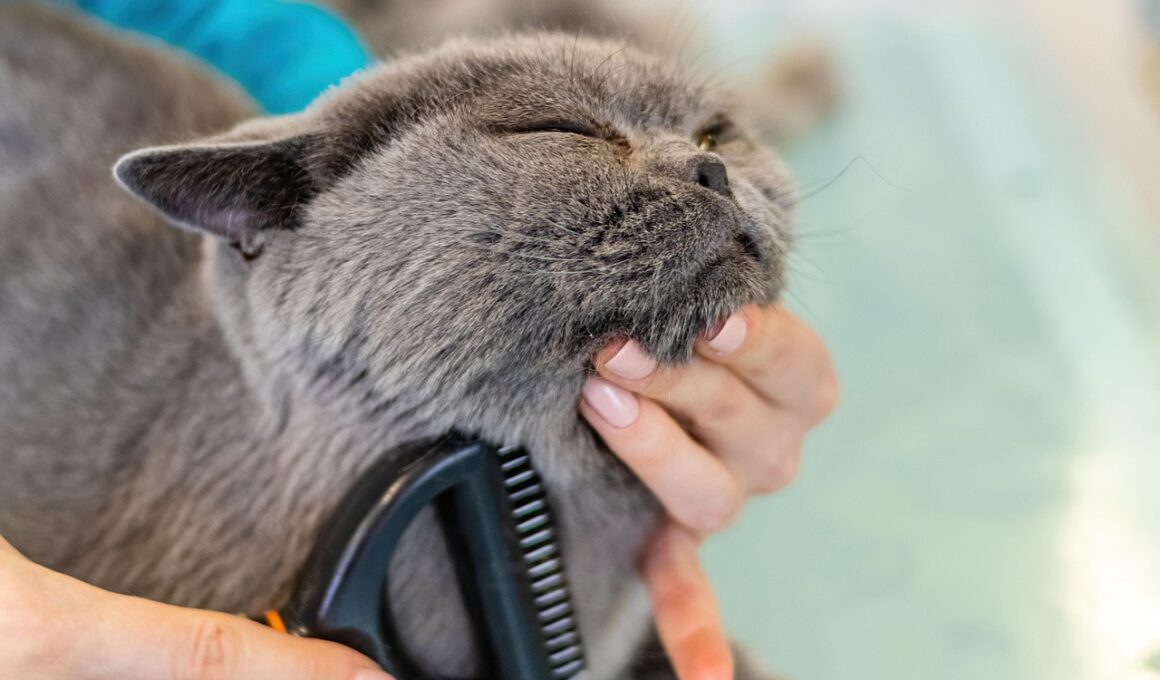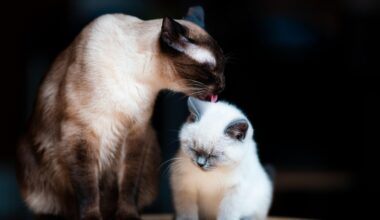How Changes in Routine Can Trigger Excessive Grooming in Cats
Cats are creatures of habit, and their routines play a vital role in their emotional stability. A sudden change in routine can lead to significant stress, which may manifest in behaviors such as excessive grooming. This behavior often serves as a coping mechanism for cats, helping them to soothe anxiety and maintain some degree of balance. Various factors can instigate changes, including new family members, moving to a new home, or even changes in the owner’s schedule. Moreover, certain environmental modifications, such as a new pet or altered living conditions, can heighten a cat’s sense of insecurity. The act of grooming becomes a way to regain control and comfort in uncertain situations. Ensuring that your cat feels safe in its environment is crucial. Providing consistent routines and familiar surroundings can mitigate stress. If you notice excessive grooming, it’s important to address potential stressors immediately. Cats can be sensitive, and reducing anxiety can help in diminishing this problematic behavior. Be attentive and observe any significant changes to their environment that may contribute to excessive grooming.
Cats can express stress in various ways, but excessive grooming is one of the more noticeable responses. This grooming often leads to bald patches, skin irritation, or even infections. Owners need to be vigilant about their cat’s grooming habits and consider behavioral factors that could cause distress. After recognizing patterns in their cats’ habits, forming a plan to address these issues becomes essential. To manage excessive grooming, owners may need to explore environmental factors contributing to this reaction. This exploration often includes analyzing interactions with other pets or people in the household. Some cats thrive on routine, making sudden disruptions particularly challenging. Regularly scheduled feeding times, playtimes, and quiet times can provide the structure and predictability that many cats require. Incorporating enrichment activities can also distract your cat from grooming itself excessively. Activities, such as interactive toys, can keep your cat engaged. Identifying triggers and minimizing them is key in ensuring the well-being of your feline friend. If excessive grooming persists despite these efforts, consulting a veterinarian or animal behaviorist can provide additional insights and tailored solutions.
When reflecting upon open vet visits, it’s worthwhile to consider your cat’s stress levels and behavioral patterns during routine changes. Excessive grooming can lead to physical injuries and further emotional distress if left unaddressed. Before implementing solutions, monitoring your cat’s behavior consistently is essential. Your observations can help identify specific situations that elicit grooming behaviors. For example, is your cat grooming excessively after an absence or changes in household dynamics? Identifying these patterns can assist in working backwards to mitigate stress sources. The role of cat toys and environmental enrichment cannot be understated either. Introducing new, stimulating items into your cat’s environment can significantly impact its mood and stress levels. While cats may respond to behavioral changes differently, providing mental stimulation through toys and activities can effectively reduce stress-induced grooming. Traditional toys may not always be enough; consider engaging puzzle feeders or interactive toys to keep your cat mentally occupied. Creating a richer environment often provides the diversion needed for cats struggling with excessive grooming as a stress response.
Recognizing the Signs of Stress
Understanding the warning signs of stress in cats is crucial for preventing excessive grooming behaviors. Behavioral changes may not always be obvious; however, common indicators include changes in appetite, withdrawal from interaction, or vocalization increases. Stress may manifest in grooming patterns, specifically when the cat grooms to the point of creating bald patches or skin irritations. Feelings of stress can be exacerbated by ongoing changes in their environment. Thus, it’s essential to maintain a calm atmosphere both socially and environmentally. An initial step could be to provide your cat with a safe, quiet space where it can retreat when feeling anxious. Hiding spots or elevated areas often serve as mini sanctuaries. Additionally, maintaining a clean litter box and fresh water can ensure that your cat feels safe and comfortable in its primary environment. By promoting feelings of safety, the likelihood of excessive grooming due to stress can diminish. It’s important to closely observe your cat’s behavior after making changes in your routines and identify whether it affects their emotional and physical health.
Incorporating grooming routines into your cat’s daily life can also help minimize excessive self-grooming caused by stress. Regular brushing not only serves to maintain a healthy coat but can reduce overall anxiety. Cats relish the attention and comfort provided during grooming sessions, fostering trust and strengthening bonds between owner and cat. However, it’s essential to keep the grooming experiences positive; using treats or gentle petting can encourage your cat to allow interaction. Ensure that the grooming routine is consistent and gentle, catering specifically to your cat’s preferences and comfort levels. Additionally, knowing when to seek the advice of a veterinarian is crucial, especially if your cat’s grooming habits escalate or become damaging. Behaviors that indicate continued distress, such as aggressive grooming to the skin, must be addressed promptly. In these cases, a thorough check-up by a veterinarian can identify any underlying medical issues contributing to grooming issues. Employing a multifaceted approach to grooming—spanning behavioral, environmental, and health considerations—will create the best opportunities for a healthier, happier cat.
Medication may sometimes be recommended to manage excessive grooming due to severe stress or anxiety if behavioral elements do not yield satisfactory improvement. Consultation with a veterinarian specializing in feline behavior is paramount in understanding when pharmaceutical intervention is necessary. These medications can help alleviate stress and anxiety levels, which may result in a marked reduction in excessive grooming behaviors. Nonetheless, medication should ideally be seen as part of a broader treatment plan. This includes changes to the cat’s environment, routines, and activities. Fostering emotional health does not rest solely on medication; instead, medication should complement holistic approaches such as behavioral modification techniques and environmental enrichment. Owners should remain committed to understanding their cat’s moods and triggers. By doing so, they can create a more comforting environment that could minimize reliance on medication alone. A pet’s acceptance of changes is vital, as a clearer understanding of behaviors leads to a stronger relationship. Striving for balance and encouraging engagement can significantly reduce stress levels and better your pet’s quality of life.
Conclusion
Managing excessive grooming behaviors in cats requires commitment and understanding regarding the factors contributing to stress. The earlier signs of stress should always be addressed to prevent escalation and withdrawal. As a cat owner, it’s essential to provide a secure and stable environment while being attentive to their needs. Frequent interactions and positive reinforcement during grooming activities can help build trust and encourage comfort. If stress-induced grooming becomes a concern, it’s crucial to identify the triggers and mitigate them. Observing changes in routines from external factors can guide owners on how to approach adjustments beneficially. Additionally, preventative measures such as providing enrichment through toys can help distract and alleviate stressors. Incorporating a routine while being responsive to changes such as new family dynamics can support your cat’s emotional well-being. Should behaviors persist, don’t hesitate in consulting professionals who can provide tailored interventions. Prioritizing your cat’s mental and physical health should always be the cornerstone of effective pet ownership. With patience, understanding, and proper management, owners can significantly improve their feline companions’ lives.


